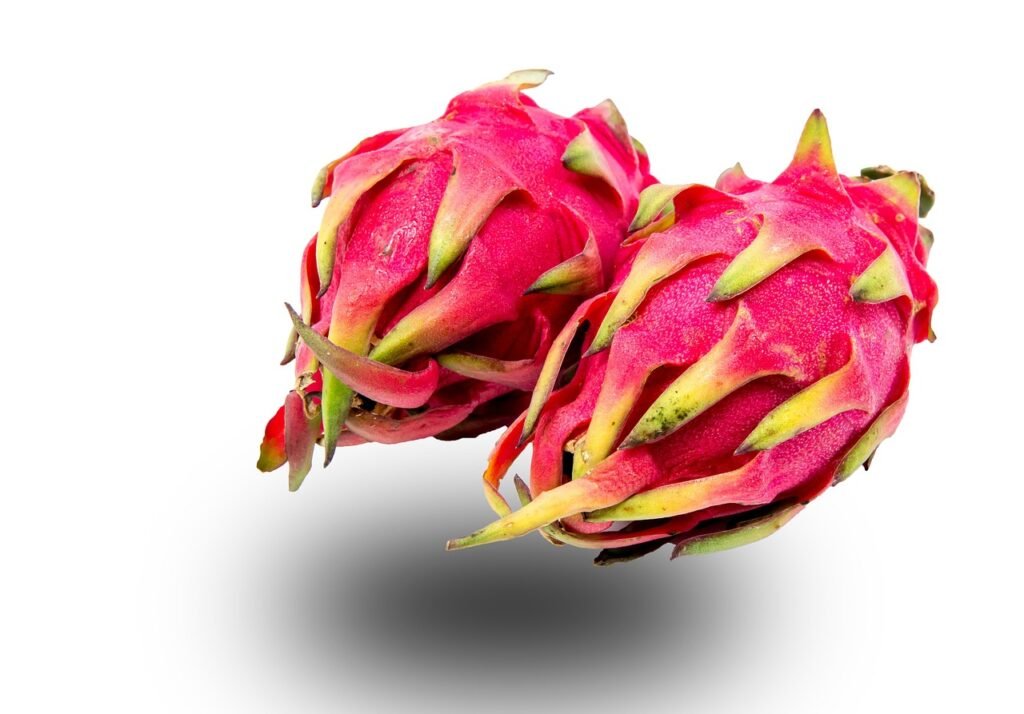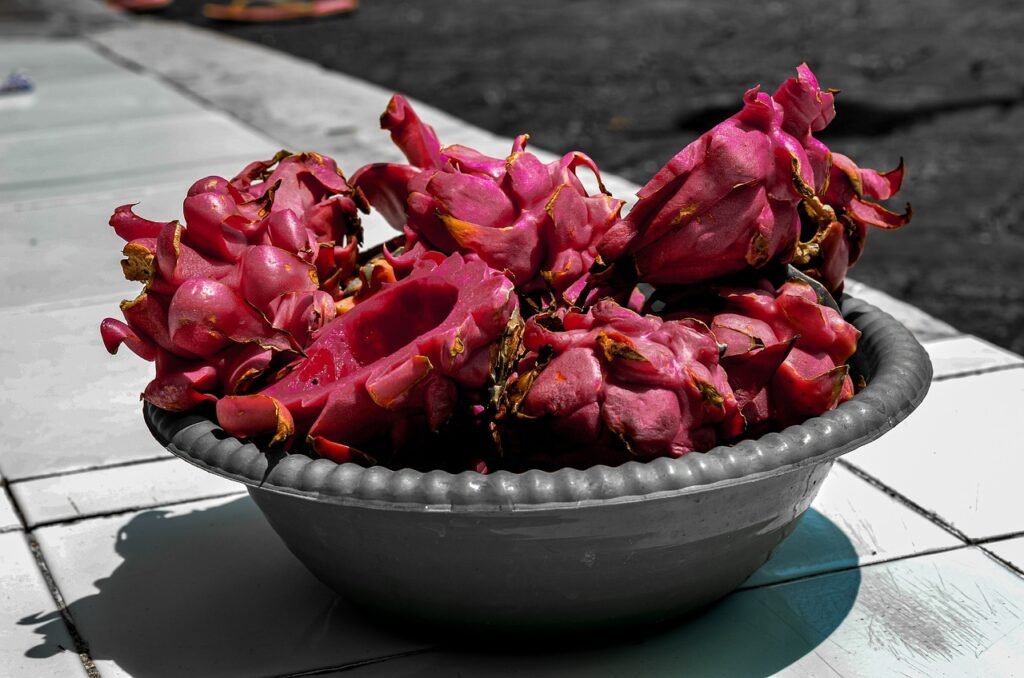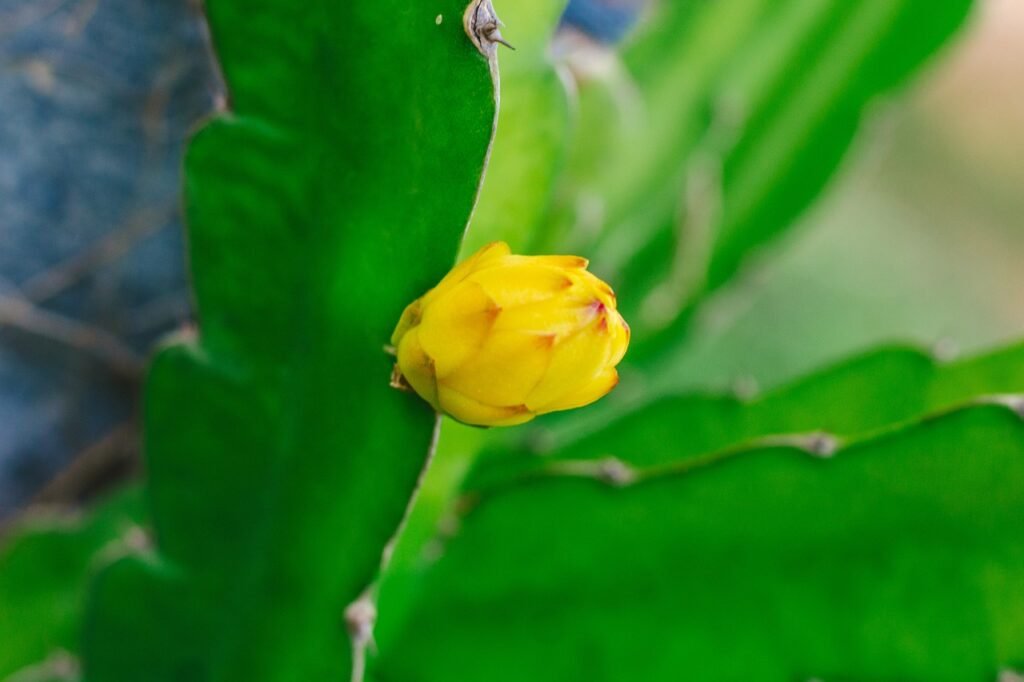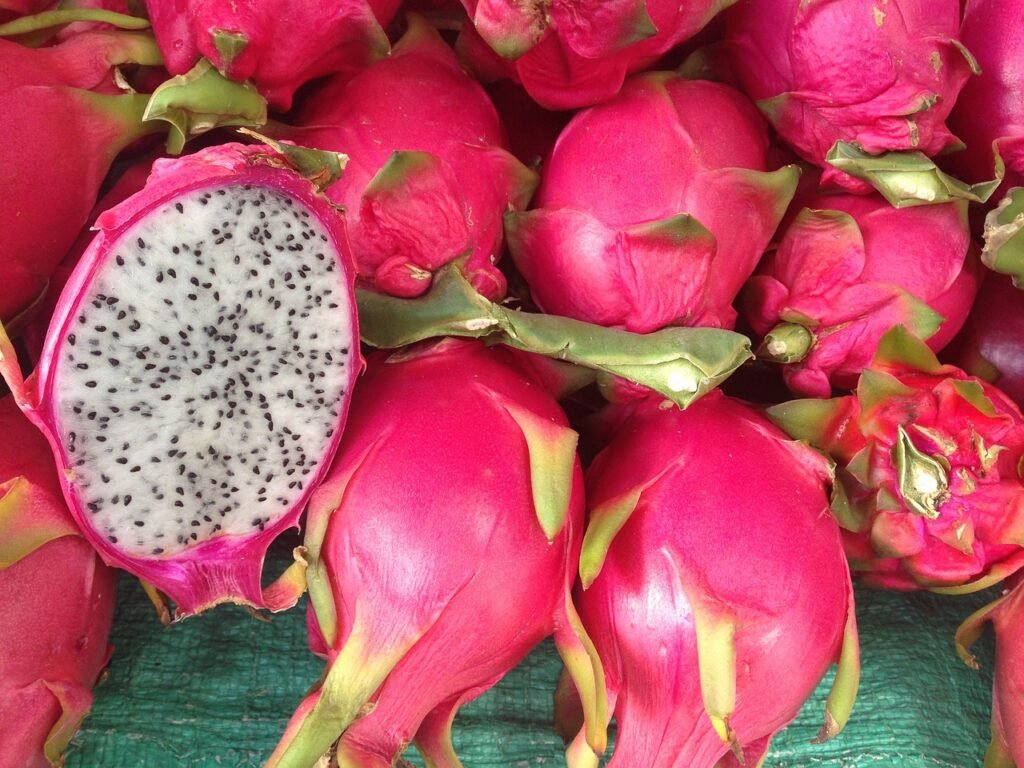Introduction
When it comes to exotic fruits, the Yellow Dragon Fruit is a true gem. Also known as the “Pitaya Amarilla,” this vibrant fruit not only captivates the eyes with its stunning yellow skin and speckled appearance but also tantalizes the taste buds with its sweet and refreshing flavor.
In this comprehensive guide, we’ll explore all aspects of the Yellow Dragon Fruit, from its origin and cultivation to its health benefits and culinary uses. So, let’s embark on this delightful journey into the world of the Yellow Dragon Fruit.
Yellow Dragon Fruit: Nature’s Colorful Creation
Yellow Dragon Fruit, scientifically known as Hylocereus megalanthus, is a tropical fruit native to South America, particularly Ecuador and Colombia. It belongs to the cactus family, and its striking appearance makes it stand out even among other exotic fruits. Here are some key characteristics:

Appearance
The Yellow Dragon Fruit is known for its vibrant yellow skin with small green scales or spikes. When cut open, it reveals a white or pale yellow flesh dotted with tiny black seeds. The contrast between the yellow skin and white flesh creates a visually appealing and appetizing look.
Taste
One of the most enticing aspects of the Yellow Dragon Fruit is its taste. It boasts a sweet and mildly tangy flavor, often likened to a blend of kiwi and pear. This delightful combination makes it a favorite among fruit enthusiasts.
Nutritional Value
Beyond its delectable taste, the Yellow Dragon Fruit is a nutritional powerhouse. It is rich in essential vitamins, particularly vitamin C, vitamin B, and vitamin A. Additionally, it offers a good dose of dietary fiber and antioxidants, making it a healthy addition to your diet.
| Aspect | Description |
| Scientific Name | Hylocereus megalanthus |
| Common Names | Yellow Dragon Fruit, Pitaya Amarilla |
| Origin | Native to South America, particularly Ecuador and Colombia |
| Appearance | Bright yellow skin with green scales |
| Taste | Sweet and mildly tangy, resembling kiwi and pear |
| Nutritional Value | Rich in vitamin C, vitamin B, vitamin A, dietary fiber, and antioxidants |
| Growth Habit | Climbing or vining cactus with aerial roots |
| Flowers | Large, fragrant, white flowers that bloom at night |
| Fruit Production | Oval or oblong-shaped fruit with juicy white or pale yellow flesh and tiny black seeds |
| Climate | Thrives in tropical and subtropical climates, sensitive to frost |
| Soil | Well-draining, sandy or loamy soil |
| Propagation | Typically propagated through cuttings from mature plants |
| Sunlight | Requires at least six hours of direct sunlight per day |
| Watering | Needs regular watering but is susceptible to root rot if overwatered |
Cultivation and Harvesting
The cultivation of Dragon Fruit in Yellow is an intricate process that requires specific conditions to thrive. Here’s what you need to know about growing this exotic fruit:

Climate
Dragon Fruit in Yellow thrives in tropical and subtropical climates. It requires a minimum temperature of 50°F (10°C) and is sensitive to frost. Therefore, it’s typically grown in regions with consistent warmth and minimal temperature fluctuations.
Soil
Well-draining, sandy or loamy soil is ideal for Yellow Dragon Fruit cultivation. The plant’s roots are sensitive to waterlogging, so proper drainage is crucial to prevent root rot.
Propagation
The most common method of propagation is through cuttings from mature plants. These cuttings are allowed to callus for a few days before being planted in the soil. Over time, they develop into new fruit-bearing plants.
Harvesting
Dragon Fruit in Yellow is usually ready for harvesting 30 to 35 days after flowering. The fruit should be plucked carefully, as it bruises easily. It’s best to harvest when the fruit is slightly soft to the touch.
Health Benefits of Yellow Dragon Fruit
Aside from its delightful taste, Yellow Dragon Fruit offers a myriad of health benefits that make it a valuable addition to your diet.

Is yellow dragon fruit good for you?
1. Rich in Antioxidants
The fruit is packed with antioxidants that help combat free radicals in the body, reducing the risk of chronic diseases and promoting overall well-being.
2. Immune Booster
With its high vitamin C content, Yellow Dragon Fruit is an excellent immune system booster. Regular consumption can help ward off infections and illnesses.
3. Digestive Health
The dietary fiber in Yellow Dragon Fruit aids in digestion and promotes a healthy gut. It can alleviate constipation and promote regular bowel movements.
4. Skin Health
The combination of vitamins A and C in this fruit contributes to healthy, glowing skin. It can help reduce signs of aging and maintain skin elasticity.
5. Weight Management
Despite its sweet taste, Yellow Dragon Fruit is relatively low in calories. It can be a satisfying and guilt-free snack for those looking to manage their weight.
6. Hydration
With its high water content, Yellow Dragon Fruit helps keep you hydrated, making it an excellent choice for hot summer days.
Yellow dragon fruit plant
The Dragon Fruit in Yellow plant, scientifically known as Hylocereus megalanthus, is a fascinating and visually striking tropical cactus. This plant is primarily grown for its delectable and nutritious fruit, the Yellow Dragon Fruit, which is known for its vibrant yellow skin and sweet, refreshing taste.

Here are some key details about the Yellow Dragon Fruit plant:
1. Growth Habit: Dragon Fruit in Yellow plants are climbing or vining cacti. They have aerial roots that help them cling to supporting structures, making them well-suited for trellises or fences.
2. Appearance: The plant itself features thick, green stems with triangular sections and spiky protrusions. These spiky parts are where the plant’s flower buds and fruit emerge.
3. Flowers: Before the fruit develops, the Yellow Dragon Fruit plant produces large, showy, white flowers that bloom during the night. These flowers are fragrant and attract pollinators, typically moths and bats.
4. Fruit Production: The Yellow Dragon Fruit plant bears fruit that is oval or oblong in shape. The fruit’s skin is bright yellow with green scales or spikes. Inside, you’ll find the juicy, white or pale yellow flesh dotted with tiny black seeds.
5. Climate: Yellow Dragon Fruit plants thrive in tropical and subtropical climates. They require warm temperatures to grow successfully and are sensitive to frost. Therefore, they are commonly cultivated in regions with consistent warmth and protection from cold weather.
6. Soil: Well-draining soil, such as sandy or loamy soil, is ideal for Yellow Dragon Fruit cultivation. Proper soil drainage is essential to prevent root rot.
7. Propagation: These plants can be propagated through cuttings taken from mature stems. These cuttings are left to dry and callus for a few days before being planted in the soil. Over time, they develop into new fruit-bearing plants.
8. Sunlight: Dragon Fruit in Yellow plants thrive in full sunlight. They require at least six hours of direct sunlight per day to grow and produce healthy fruit.
9. Watering: While these plants prefer well-draining soil, they still need regular watering, especially during the growing season. However, they are susceptible to root rot if overwatered, so it’s crucial to find the right balance.
Cultivating your own Dragon Fruit in Yellow plant can be a rewarding experience, allowing you to enjoy the fresh and delicious fruit right from your garden. Just remember to provide it with the right conditions, including warmth, sunlight, well-draining soil, and proper care. With a little effort and patience, you can have your own supply of this exotic and nutritious fruit.
Which colour dragon fruit is best?
The choice of the best dragon fruit color depends on personal preference and dietary needs. Both red and white dragon fruits have their unique qualities, and what’s “best” for one person may not be the same for another. Let’s explore the characteristics of each:
Red Dragon Fruit (Hylocereus spp.):
Appearance: Red dragon fruit, also known as pitaya or pitahaya, has vibrant pink or red skin with green scales. The flesh inside can range from white to deep magenta, depending on the variety.

Flavor: Red dragon fruit typically has a mildly sweet and subtly tangy flavor, somewhat reminiscent of a kiwi. The taste is often described as refreshing.
Nutrition: It is rich in antioxidants, vitamin C, dietary fiber, and essential minerals. The deep-colored varieties are known to have higher antioxidant content.
White Dragon Fruit (Hylocereus undatus):
Appearance: White dragon fruit, also known as pitahaya blanca, features bright pink or yellow skin with green scales. The flesh inside is white with tiny black seeds, similar in appearance to sesame seeds.
Flavor: White dragon fruit is milder in flavor compared to the red variety. It has a subtle sweetness with a hint of pear and kiwi flavors. Some find it less tangy and more delicate on the palate.
Nutrition: Like its red counterpart, white dragon fruit is a good source of vitamin C, dietary fiber, and antioxidants. It is often considered lower in calories and carbohydrates.
Choosing the “Best” Dragon Fruit:
Flavor Preference: If you prefer a sweeter, slightly tangy taste, you might lean toward red dragon fruit. However, if you like a milder, more delicate flavor, white dragon fruit could be your choice.
Visual Appeal: Some people are drawn to the vibrant colors of red dragon fruit, while others appreciate the elegant simplicity of white dragon fruit.
Nutritional Goals: If you’re looking for a higher antioxidant content, the red variety might be more suitable. For those focusing on lower calorie or carbohydrate intake, white dragon fruit may be preferred.
How to Enjoy Yellow Dragon Fruit
Now that you’re aware of the numerous health benefits of Yellow Dragon Fruit, let’s explore some delightful ways to enjoy this exotic fruit:
1. Fresh and Simple
The easiest way to enjoy Yellow Dragon Fruit is by simply cutting it in half and scooping out the flesh with a spoon. Its natural sweetness and refreshing taste are best appreciated in its unadulterated form.
2. Fruit Salad
Add chunks of Yellow Dragon Fruit to your fruit salad for an exotic twist. Its vibrant color and sweet flavor will elevate the overall taste of the salad.
3. Smoothies
Blend Yellow Dragon Fruit with other tropical fruits like mango, pineapple, and banana to create a delicious and nutritious smoothie.
4. Sorbet or Ice Cream
Freeze the pulp of Yellow Dragon Fruit and blend it into a sorbet or mix it with vanilla ice cream for a delightful dessert.
5. Cocktails
For those who enjoy mixed drinks, Dragon Fruit in Yellow can be muddled into cocktails or used as a colorful garnish.
Conclusion
The Yellow Dragon Fruit, with its striking appearance, sweet taste, and numerous health benefits, is truly a gift from nature. Whether you enjoy it fresh, in a smoothie, or as a colorful addition to your fruit salad, this exotic fruit is sure to brighten your culinary adventures. So, don’t hesitate to explore the world of Yellow Dragon Fruit and savor its unique flavors and benefits. Incorporating this delightful fruit into your diet can be a rewarding and healthy choice.
Remember, nature’s treasures like the Yellow Dragon Fruit are meant to be shared and enjoyed. So, why not share this article with your friends and family so they too can discover the wonders of this exotic fruit?
FAQs
Can I eat the seeds of Yellow Dragon Fruit?
Yes, the seeds of Dragon Fruit are edible and provide a pleasant crunch when consumed along with the flesh.
How do I know if a Yellow Dragon Fruit is ripe?
A ripe Dragon Fruit should give slightly when gently pressed. Its skin should also have a bright yellow color with minimal green areas.
Are there any side effects of consuming Dragon Fruit?
No, Yellow Dragon Fruit is generally safe for consumption. However, some individuals may be allergic to it, so it’s advisable to consume a small amount if you’re trying it for the first time.
Can Dragon Fruit in Yellow be grown at home?
Yes, it is possible to grow Yellow Dragon Fruit at home, but it requires proper care and attention to temperature and soil conditions.
Is Dragon Fruit in Yellow genetically modified?
No, Yellow Dragon Fruit is a natural fruit and is not genetically modified.
What other fruits are similar in taste to Dragon Fruit in Yellow ?
Fruits like kiwi, pear, and guava share some flavor characteristics with Yellow Dragon Fruit, making them good alternatives if you can’t find it.





